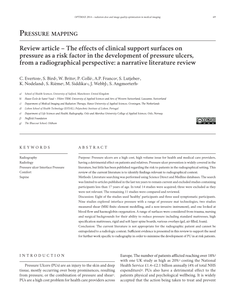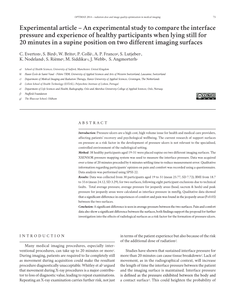Purpose: Pressure ulcers are a high cost, high volume issue for health and medical care providers, having a detrimental effect on patients and relatives. Pressure ulcer prevention is widely covered in the literature, but little has been published regarding the risk to patients in the radiographical setting. Thisreview of the current literature is to identify findings relevant to radiographical context.Methods: Literature searching was performed using Science Direct and Medline databases. The search was limited to articles published in the last ten years to remain current and excluded studies containing participants less than 17 years of age. In total 14 studies were acquired; three were excluded as they were not relevant. The remaining 11 studies were compared and reviewed.Discussion: Eight of the studies used ‘healthy’ participants and three used symptomatic participants. Nine studies explored interface pressure with a range of pressure mat technologies, two studies measured shear (MRI finite element modelling, and a non-invasive instrument), and one looked at blood flow and haemoglobin oxygenation. A range of surfaces were considered from trauma, nursing and surgical backgrounds for their ability to reduce pressure including standard mattresses, high specification mattresses, rigid and soft layer spine boards, various overlays (gel, air filled, foam).Conclusion: The current literature is not appropriate for the radiographic patient and cannot be extrapolated to a radiologic context. Sufficient evidence is presented in this review to support the need for further work specific to radiography in order to minimise the development of PU in at risk patients.
DOCUMENT

Introduction: Pressure ulcers are a high cost, high volume issue for health and medical care providers, affecting patients’ recovery and psychological wellbeing. The current research of support surfaces on pressure as a risk factor in the development of pressure ulcers is not relevant to the specialised, controlled environment of the radiological setting. Method: 38 healthy participants aged 19-51 were placed supine on two different imaging surfaces. The XSENSOR pressure mapping system was used to measure the interface pressure. Data was acquired over a time of 20 minutes preceded by 6 minutes settling time to reduce measurement error. Qualitative information regarding participants’ opinion on pain and comfort was recorded using a questionnaire. Data analysis was performed using SPSS 22. Results: Data was collected from 30 participants aged 19 to 51 (mean 25.77, SD 7.72), BMI from 18.7 to 33.6 (mean 24.12, SD 3.29), for two surfaces, following eight participant exclusions due to technical faults. Total average pressure, average pressure for jeopardy areas (head, sacrum & heels) and peak pressure for jeopardy areas were calculated as interface pressure in mmHg. Qualitative data showed that a significant difference in experiences of comfort and pain was found in the jeopardy areas (P<0.05) between the two surfaces. Conclusion: A significant difference is seen in average pressure between the two surfaces. Pain and comfort data also show a significant difference between the surfaces, both findings support the proposal for further investigation into the effects of radiological surfaces as a risk factor for the formation of pressure ulcers.
DOCUMENT

Of all patients in a hospital environment, trauma patients may be particularly at risk for developing (device-related) pressure ulcers (PUs), because of their traumatic injuries, immobility, and exposure to immobilizing and medical devices. Studies on device-related PUs are scarce. With this study, the incidence and characteristics of PUs and the proportion of PUs that are related to devices in adult trauma patients with suspected spinal injury were described. From January–December 2013, 254 trauma patients were visited every 2 days for skin assessment. The overall incidence of PUs was 28⋅3% (n = 72/254 patients). The incidence of device-related PUs was 20⋅1% (n = 51), and 13% (n = 33) developed solely device-related PUs. We observed 145 PUs in total of which 60⋅7% were related to devices (88/145). Device-related PUs were detected 16 different locations on the front and back of the body. These results show that the incidence of PUs and the proportion of device-related PUs is very high in trauma patients
DOCUMENT

Abstract—Pressure ulcers (PUs) are highly prevalent in people with spinal cord injury (SCI). Electrical stimulation (ES) activates muscles and might reduce risk factors. Our objectives were to study and compare the effects of two duty cycles during 3 h of ES-induced gluteal and hamstring activation on interface pressure distribution in sitting individuals with SCI and study the usability of a newly developed electrode garment (ES shorts). Ten individuals with SCI participated in this study, in which two ES protocols with different duty cycles (1:1 s vs 1:4 s on-off) were applied in counterbalanced order using a custom-made garment with built-in electrodes. Outcome variables included interface pressure of the ischial tuberosities (ITs) and pressure gradient. A questionnaire was used to determine usability of the ES shorts. In both protocols, ES caused a significant decrease in average IT pressure compared with rest (no ES); on average, 35% for protocol 1:4 and 13% for protocol 1:1. The ES on-off duty cycle of protocol 1:4 showed less muscle fatigue. In general, participants scored the usability of the ES shorts as satisfactory. In this study, the application of ES resulted in a significant decrease in IT pressure. The ES on-off duty cycle of 1:4 s is recommended because of the less fatiguing effect. ES of the hamstrings and gluteal muscles might be a promising method in preventing PUs, but further study is needed.
DOCUMENT
Purpose – Over 8 per cent of the Dutch nursing home population is bedfast, and this number is slowly increasing. The quality of life (QoL) of this population is lower than that of residents who are still mobile. Little research has been conducted on how to improve the QoL of this bedfast population, particularly through making technological adjustments to the bed and the direct surroundings. The purpose of this paper is to gain insight into the QoL of bedfast residents and how to improve this through technology. Design/methodology/approach – A mixed-method multi-case study with thematic analysis was conducted in two nursing homes with seven participants based on semi-structured interviews and Short Form-12 questionnaire. Findings – The major causes of the experienced low QoL were the limited opportunities for engaging in social contacts with others, and coping with the dependency on other people and having limited control. Participants suggested improvements of QoL through the application of modern ccommunication technologies to engage in social contacts and to control the bed itself and environment around the bed. Practical implications – The results may help improve the design of the bed and the direct environment in order to improve the QoL of bedfast nursing home residents. Originality/value – The QoL of bedfast nursing home residents has not been studied before in relation to the bed itself and technological solutions that may help improve the QoL and level of control. CC BY Published by Emerald Publishing Limited Original article: https://doi.org/10.1108/JET-01-2018-0003 https://www.dehaagsehogeschool.nl/onderzoek/lectoraten/details/urban-ageing#over-het-lectoraat
MULTIFILE

Background: A new selective preventive spinal immobilization (PSI) protocol was introduced in the Netherlands. This may have led to an increase in non-immobilized spinal fractures (NISFs) and consequently adverse patient outcomes. Aim: A pilot study was conducted to describe the adverse patient outcomes in NISF of the PSI protocol change and assess the feasibility of a larger effect study. Methods: Retrospective comparative cohort pilot study including records of trauma patients with a presumed spinal injury who were presented at the emergency department of a level 2 trauma center by the emergency medical service (EMS). The pre-period 2013-2014 (strict PSI protocol), was compared to the post-period 2017-2018 (selective PSI protocol). Primary outcomes were the percentage of records with a NISF who had an adverse patient outcome such as neurological injuries and mortality before and after the protocol change. Secondary outcomes were the sample size calculation for a larger study and the feasibility of data collection. Results: 1,147 records were included; 442 pre-period, and 705 post-period. The NISF-prevalence was 10% (95% CI 7-16, n = 19) and 8% (95% CI 6-11, n = 33), respectively. In both periods, no neurological injuries or mortality due to NISF were found, by which calculating a sample size is impossible. Data collection showed to be feasible. Conclusions: No neurological injuries or mortality due to NISF were found in a strict and a selective PSI protocol. Therefore, a larger study is discouraged. Future studies should focus on which patients really profit from PSI and which patients do not.
DOCUMENT

The objective of this study is to investigate the heart rate (HR) accuracy measured at the wrist with the photoplethysmography (PPG) technique with a Fitbit Charge 2 (Fitbit Inc) in wheelchair users with spinal cord injury, how the activity intensity affects the HR accuracy, and whether this HR accuracy is affected by lesion level.
MULTIFILE
